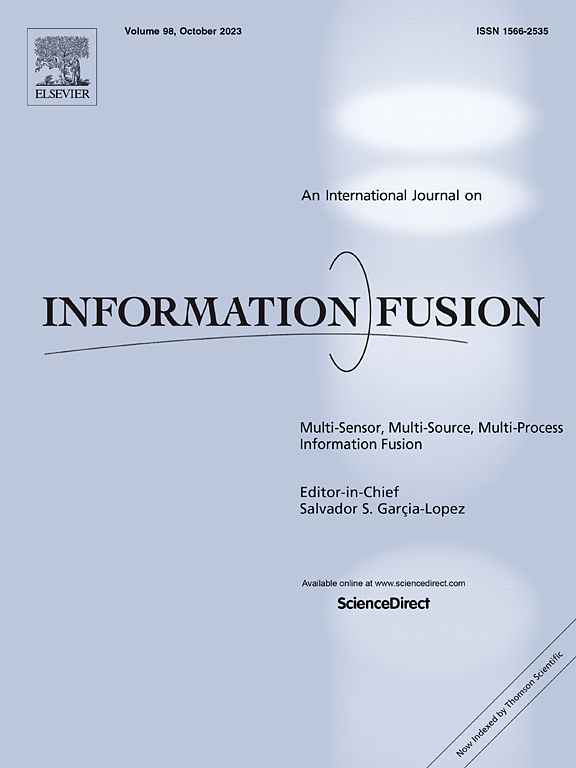MCNet: A multi-level consistency network for 3D point cloud self-supervised learning
IF 14.7
1区 计算机科学
Q1 COMPUTER SCIENCE, ARTIFICIAL INTELLIGENCE
引用次数: 0
Abstract
With the rapid advancement of computer vision and artificial intelligence, point clouds have become a pivotal representation of 3D data. However, practical applications of point clouds are hindered by challenges such as noise, structural sparsity, and information occlusion, which complicate computations and degrade the performance of high-precision analyses. While self-supervised learning has proven effective in reducing reliance on annotated data, existing methods predominantly focus on local features, often neglecting global structures and the balance between geometric and semantic information. This paper introduces the Multi-level Consistency Network (MCNet), a novel framework designed to comprehensively explore multi-level feature information in point clouds. MCNet integrates geometric, structural, and high-order semantic supervisory signals, fostering alignment and complementarity of features through self-supervised learning. We propose the Global–Local Synergistic Noise Module (GLSNM), which combines Principal Component Analysis-based Non-Local Noise Addition (PCA-NLNA) with Mask-based Local Noise Injection (Mask-LNI) to balance the preservation of global structures and local details. Additionally, we develop the Multi-level Information Reconstruction Module (MIRM), which employs an attention fusion mechanism to dynamically balance geometric and high-order semantic information, thereby enhancing the model’s feature extraction capabilities in complex environments. Extensive experiments demonstrate that MCNet consistently outperforms existing methods across multiple tasks, including meta-classification, few-shot classification, real-world scene classification, fine-grained classification, and segmentation. These results validate the effectiveness of MCNet and its significant contribution to the field of point cloud processing.
MCNet:用于三维点云自监督学习的多层次一致性网络
随着计算机视觉和人工智能的快速发展,点云已经成为三维数据的关键表征。然而,点云的实际应用受到噪声、结构稀疏性和信息遮挡等挑战的阻碍,这些挑战使计算复杂化,降低了高精度分析的性能。虽然自监督学习已被证明在减少对注释数据的依赖方面是有效的,但现有的方法主要关注局部特征,往往忽略了全局结构以及几何和语义信息之间的平衡。本文介绍了多层次一致性网络(Multi-level Consistency Network, MCNet),这是一种综合挖掘点云多层次特征信息的新框架。MCNet集成了几何、结构和高阶语义监督信号,通过自我监督学习促进特征的对齐和互补。我们提出了全局-局部协同噪声模块(GLSNM),它结合了基于主成分分析的非局部噪声添加(PCA-NLNA)和基于掩模的局部噪声注入(Mask-LNI)来平衡全局结构和局部细节的保留。此外,我们还开发了多级信息重构模块(MIRM),该模块采用注意力融合机制动态平衡几何信息和高阶语义信息,从而增强了模型在复杂环境下的特征提取能力。大量实验表明,MCNet在多个任务上始终优于现有方法,包括元分类、少镜头分类、真实场景分类、细粒度分类和分割。这些结果验证了MCNet的有效性及其对点云处理领域的重大贡献。
本文章由计算机程序翻译,如有差异,请以英文原文为准。
求助全文
约1分钟内获得全文
求助全文
来源期刊

Information Fusion
工程技术-计算机:理论方法
CiteScore
33.20
自引率
4.30%
发文量
161
审稿时长
7.9 months
期刊介绍:
Information Fusion serves as a central platform for showcasing advancements in multi-sensor, multi-source, multi-process information fusion, fostering collaboration among diverse disciplines driving its progress. It is the leading outlet for sharing research and development in this field, focusing on architectures, algorithms, and applications. Papers dealing with fundamental theoretical analyses as well as those demonstrating their application to real-world problems will be welcome.
 求助内容:
求助内容: 应助结果提醒方式:
应助结果提醒方式:


